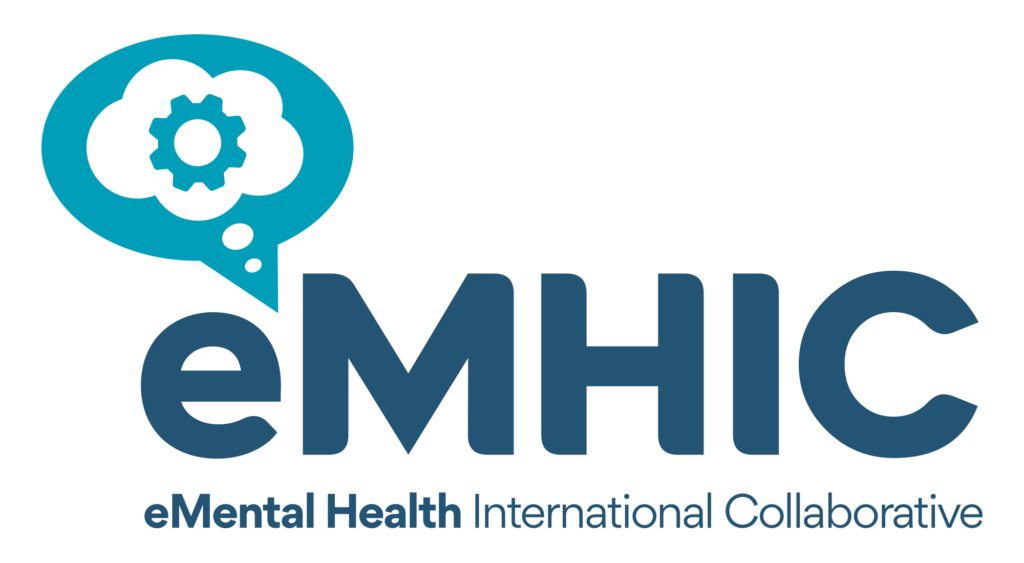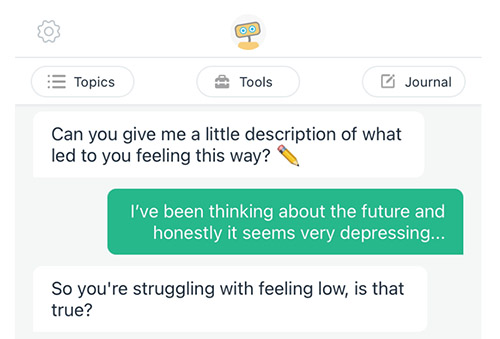Every day, we see reminders that mental health is a human and economic crisis. The tumult of the pandemic and the isolation it has created has affected us all, but getting help has been a significant challenge for many. Stigma is one barrier. But the pandemic has amplified another reality: there are simply not enough qualified professionals available to treat the millions of people who need help.
There is a ray of hope, and it’s in a future where technology and health care converge to make mental health accessible to everyone.
For Woebot Health, that convergence took root back in 1999, when Dr. Alison Darcy met with a friend who was working to solve the problem of unsustainable support group networks for people living with eating disorders and their families. The groups were expensive to run, difficult to maintain, and didn’t address people’s needs. That formative meeting that would spark an idea to turn locally run groups into accessible, facilitated online support groups. And it would turn Dr. Darcy’s experience into a passion for learning how to translate successful in-person therapeutic models to tech-delivered platforms, and in the process solve the problem of access and stigma at its core.
A few years later, with a Ph.D. from University College, Dublin and a postdoctoral fellowship from Stanford University, Alison began a collaboration with Andrew Ng, the globally renowned AI expert, founder of Coursera, and Adjunct Professor at Stanford University. She went on to run Andrew’s Health Innovation Lab in Computer Science at Stanford and later explored how to integrate human-centered design thinking and big datasets into research on technology-based psychotherapy. Here again, the experience of working at the intersection of technology and health care led to a completely new way of thinking about digital mental heath, and the development of a program that eventually became known as Woebot.
Woebot: A Coach for Life’s Ups and Downs
Today, Woebot is a “coach for life’s ups and downs” that has helped more than one million people identify and cope with various mental health challenges, including stress, anxiety and depression.
Available as an app on smartphones, Woebot works by inviting people to have a conversation. In fact, the core Woebot experience itself is just that: a simulated, supportive and empathetic conversation that aims to engage people in the core activities of cognitive behaviour therapy (CBT), the leading approach to mental health. Woebot’s conversational interface can facilitate an easier first step towards getting help, because conversation is something that comes naturally to human beings. It’s the most intimate and natural way to work through a problem when feeling down or overwhelmed.
At Woebot’s heart is a complex, technology-enabled framework that uses clinically-validated approaches as well as Artificial Intelligence (AI) and Natural Language Processing (NLP) techniques to understand and adapt to a user’s emotional state and cognitive ability, and to safely deliver the right intervention to the right person at the right time. Woebot’s tailoring algorithm personalizes the experience according to the user’s mood, the description of the problem at hand, and their progress through the program to date. With CBT as its base, Woebot also draws from dialectical behavioral therapy (DBT) and interpersonal therapy (IPT) to find the right approach for the person and the problem they are encountering. Darcy says this mix of techniques and tools “hasn’t been available in purely digital mental health solutions before, which tend to use a one-size-fits-all approach, and it may be a key enabler in reducing the burden of mental illness in large populations.”
Woebot was designed to function as an effective gateway to mental health support, a reinforcement to human-delivered treatment, or as an approachable and accessible option for those who may otherwise avoid or cannot access in-person treatment. Since its launch in 2018, it has been used by people in more than 120 countries, despite the fact that it’s currently only available in English. All ages use Woebot, from 18 all the way through 65 and above. In terms of self-reported gender, many self-identified males are using Woebot, which is bringing a group more affected by stigma into the conversation about mental health.
Woebot is the foundation of the digital therapeutics company Dr. Darcy created, and is key to its mission: to transform mental health care through human-centric technology, making care more accessible, scalable and personal and, ultimately, effective.
The Efficacy of Human-Centric Technology
Woebot Health’s initial controlled study conducted at Stanford University showed that using Woebot led to significant reductions in anxiety and depression among people aged 18-28 years old. A recent study in substance use disorder, published in JMIR, showed that people with SUD who used Woebot while sheltering in place experienced a 30% decrease in substance use occasions, a 50% decrease in cravings, an increased confidence to resist urges (36%) and a decrease in symptoms of depression (21%) and anxiety (23%).
But it’s the company’s latest study that is getting the most attention. Titled “Evidence of human-level bonds established with a digital conversational agent,” and published in the open access journal JMIR Formative Research, the study among a sample of 36,070 users provided evidence that Woebot establishes a therapeutic bond with users—a construct long thought to be the unique domain of human-to-human interactions. The findings are unprecedented in a commercialized product and could mark a foundational step toward purely digital solutions’ ability to help meet surging demand for mental health care.
Bond, or therapeutic alliance in clinical terms, reflects the rapport that develops between participants and Woebot. In psychotherapy, close rapport between therapist and client is considered a predictor of the level of change achieved. According to the study, the bond that Woebot formed with users appeared to be non-inferior to the bond created between human therapists and patients. Participants’ bond with Woebot was also established in just 3-5 days—far faster than the bond scores in the comparison studies that were all measured between 2 and 6 weeks. Additionally, bond with Woebot does not appear to diminish over time.
Darcy says that many factors made it possible for the company to architect a bond in a digital solution. “It’s very complex, but we have a very deliberate approach. To start, we have a team of incredible clinicians and designers and therapeutic writers. They are thoughtful, warm and empathic individuals, and that comes through in the writing. But there are key principles that guide our design. Transparency is one of the top ones, and something we think has been absent for a long time in technology. Woebot’s core values also guide our design. And we spend a lot of time talking to people who are going through the specific experience that we’re building for. When you deeply understand the lived experience of individuals, then that’s where great empathy comes from.”
Dr. Darcy adds the implications of the study for the field of mental health are significant, “Now that we’re able to show that we really can establish a therapeutic bond using just an automated relational agent, it means that maybe we can get better outcomes in some of these purely automated, purely self-directed approaches. And that’s really significant because it makes high quality services much more scalable. This could be incredibly impactful for our ability to reduce the burden of illness.”
The future of tech-enabled mental health
Darcy says she is often asked if her goal is to replace human therapists. “There’s no replacement for human therapists. But there are tens of millions of people living with depression and anxiety, and only so many clinicians available to see them. We’re well past the point where the only solution in sight is a 1:1 in person visit with a human. AI can be a powerful tool for breaking down stigma-driven barriers because it doesn’t judge, or feel or think anything. It can simply help people sort through their thoughts and emotions, and teach strategies for identifying and moving past distorted thought patterns.”
Woebot Health is currently available on app stores, but the company is piloting and deploying behavioral health offerings with payer and provider networks as well as other consumer health companies to provide broad and scalable access to mental health solutions and support its commercial strategy to address unmet needs across the care continuum.
The company is also validating its technology at the highest levels, through regulatory approval and clinical validation. One of its lead digital therapeutics candidates, WB001, indicated for women with postpartum depression, just received the FDA’s Breakthrough Device designation. And in its short four year history, the company has amassed more mentions in the peer-reviewed scientific literature than most any other digital therapeutics company.
These are all strong signals of interest in a future where relational agents like Woebot will be a core part of a global health care system enabling a longitudinal perspective of human health. Dr. Darcy says she sees a future where relational technology engages people in their mental health across a lifetime.
“Right now, we interact with our health systems in a problem-focused, discreet way. But human beings are continuous. If our care systems were continuous too, we could drive a much better experience and be more preventative.”
About Woebot Health:
Founded in 2017, Woebot Health has created relational technologies that underpin a new generation of digital therapeutics and tools for mental health. The company’s proprietary relational agent, Woebot, is capable of quickly forming a bond with users and delivering human-like therapeutic encounters that are psychologically related, responsive to a person’s dynamic state of health, and targeted using multidisciplinary tools. Woebot is at the heart of the company’s AI-powered platform and the foundation for digital therapeutics and tools that seamlessly integrate within health ecosystems and solve for gaps along the health care journey. For more information, visit woebothealth.com, or follow Woebot on Facebook, Twitter and LinkedIn.
Contact: Jim Murray, Vice President, Business Development and Enterprise Partnerships, Woebot Health Jim@woebothealth.com




